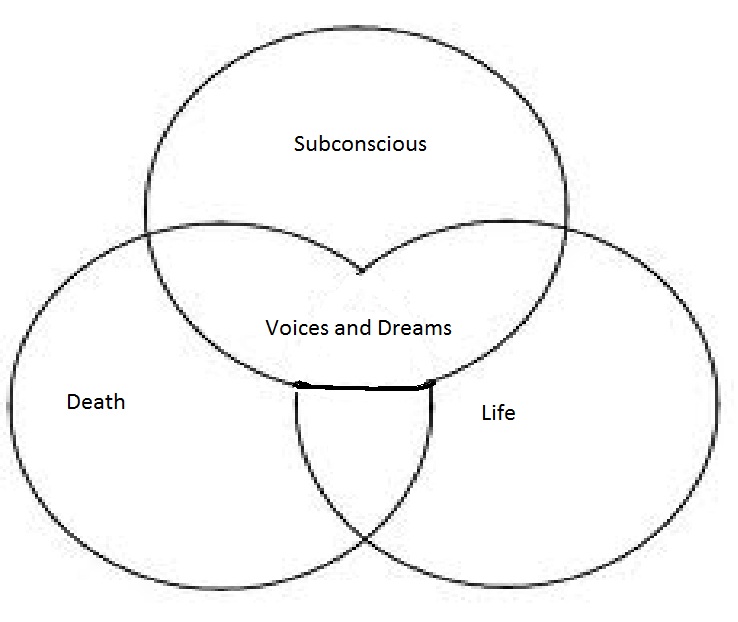Due to the nature of this assignment, I will present my main arguments on this page and link around to other sources. About half of this page is my precis. Don’t forget, the images have alt text.
Dylan Thomas labeled Under Milk Wood as a Play for Voices and not as a radio play. The vocal influence throughout the play works to mediate what would normally be presented as unmediated life, death, or thought in a normal stage play. Yet all of these sources mediate one another and are mediated by sound. Henry W. Wells notes that there are only about fifty stage directions and that the play is ten parts voice to one part noise. (First column, last paragraph).
This real lack of environmental sounds implies that this is a play for only voices. The rest of the major themes–death, life, dreams, and the subconscious, are merely gears in the same machine.
So, this hypertext project’s organizing principle is to decipher and organize the the multiple mediation at play in Under Milk Wood.
This page will set out to answer the following questions:
1. How does voice operate in and mediate this play, and how does it interact with other themes?
2. How do death, dreams, life, and the subconscious relate and play on one another? (See below for an explanation of these terms in greater details)
Firstly, allow me to define these terms, as I use them, in greater detail:
Voice—What I will argue is the main mediating factor in the play. It is the fabric of existence for this radio play and the main (and only) way for the characters to express themselves. It plays a part in all aspects of the play I discuss, including dreams, death, and life. It would not be appropriate to provide a link to examples of this, as it is essentially everything in this play. I’ll just link you to my close readings.
Dreams— A third realm between death and life (this is illustrated in the image below) which Thomas sets out as a mediator between the two. Dreams are the second most prevalent mediator in the play, operating between the subconscious and life, death and life, the subconscious and death, and voices and death. [click here for examples and close reading of dream sequences in the play]
Death—Typically impossible to puncture in our real life, Under Milk Wood feels no need to provide an invincible boundary between the realms of death and life. [see here for close reading on the ways Death operates in the play]
Life—The external experience of the characters and the events that take place in the character’s real-life (not dream) world make up life. It is a realm that serves as the polar opposite of death. Like the subconscious, it is also a source that is mediated by other factors in the play. [see here for close reading of the play’s specific form of life]
Subconscious— Hidden in the inner cavity of the mind, the subconscious is my one word version of what basically amounts to inner human thoughts, emotions, and feelings. The connotation this phrase carries is not only that of an abstract inside world filled with negative feelings like guilt, sadness, and longing, but also as the source of pure thought. In the play, the subconscious of the varying characters are the originator of feelings and thoughts, which are mediated by other factors. [read about it in a few close reading instances here]
This is the initial format of the mediators in Under Milk Wood. Upon first glance, the themes and their relationship to each other look something like this:
But some of these mediators overlap, you say! This is how they overlap:
These themes, however, operate in different ways than just by being in separate realms. Voice encompasses all of the play, death is such a major part that it shouldn’t really be a bigger realm than voice, the subconscious also serves as an important piece to the puzzle, and the life of the characters is rather important to the entire functionality of the play. All these concepts cannot really be represented as independent forces. Voice and dreams operate very differently, but the ven diagram limits them to the same location. In light of all of these interlocking concepts, perhaps Under Milk Wood is not like the images above. Perhaps it is more like a set of gears, each theme a cog and all of them interacting with one another at varying intervals and each cog having a different but vital role to play in Under Milk Wood. Like this:
The reason the voice cog is the red one (the one that borders the entire image) is because it mediates and affects the entire play. Every other theme is encompassed within voice. The second biggest cog–Death–is that gear for the very reason that it permeates and affects most of the play, but not quite all of it. Life is the green cog because it operates off the subconscious, death, and love. The subconscious aspect of the play builds on the lives of the characters. Love (romantic true love, at least) hardly makes an appearance in the play, but remains a relevant element.
Thanks for reading!
S. Meeker


